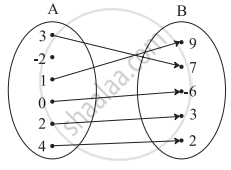Advertisements
Advertisements
Question
Answer the following:
Find the domain of the following function.
f(x) = `sqrt(x - x^2) + sqrt(5 - x)`
Solution
f(x) = `sqrt(x - x^2) + sqrt(5 - x)`
x – x2 ≥ 0
∴ x2 – x ≤ 0
∴ x(x – 1) ≤ 0
∴ 0 ≤ x ≤ 1 ...(i)
5 – x ≥ 0
∴ x ≤ 5 ...(ii)
Intersection of intervals given in (i) and (ii) gives
Solution set = [0, 1]
∴ Domain = [0, 1]
APPEARS IN
RELATED QUESTIONS
What is the fundamental difference between a relation and a function? Is every relation a function?
f, g, h are three function defined from R to R as follow:
(ii) g(x) = sin x
Find the range of function.
Let X = {1, 2, 3, 4} and Y = {1, 5, 9, 11, 15, 16}
Determine which of the set are functions from X to Y.
(c) f3 = {(1, 5), (2, 9), (3, 1), (4, 5), (2, 11)}
If f(x) = (x − a)2 (x − b)2, find f(a + b).
If \[f\left( x \right) = x^3 - \frac{1}{x^3}\] , show that
If f(x) = loge (1 − x) and g(x) = [x], then determine function:
(iii) \[\frac{f}{g}\]
Write the range of the function f(x) = ex−[x], x ∈ R.
Write the domain and range of the function \[f\left( x \right) = \frac{x - 2}{2 - x}\] .
f is a real valued function given by \[f\left( x \right) = 27 x^3 + \frac{1}{x^3}\] and α, β are roots of \[3x + \frac{1}{x} = 12\] . Then,
If \[3f\left( x \right) + 5f\left( \frac{1}{x} \right) = \frac{1}{x} - 3\] for all non-zero x, then f(x) =
If f : R → R be given by for all \[f\left( x \right) = \frac{4^x}{4^x + 2}\] x ∈ R, then
The domain of the function \[f\left( x \right) = \sqrt{5 \left| x \right| - x^2 - 6}\] is
If f(x) = ax2 + bx + 2 and f(1) = 3, f(4) = 42, find a and b.
Check if the following relation is a function.

Check if the relation given by the equation represents y as function of x:
x2 − y = 25
If f(m) = m2 − 3m + 1, find f(− x)
Find x, if g(x) = 0 where g(x) = `(18 -2x^2)/7`
Check the injectivity and surjectivity of the following function.
f : N → N given by f(x) = x3
Show that if f : A → B and g : B → C are one-one, then g ° f is also one-one
lf f(x) = 3(4x+1), find f(– 3)
Express the following exponential equation in logarithmic form
`"e"^(1/2)` = 1.6487
Express the following logarithmic equation in exponential form
`log_5 1/25` = – 2
Express the following logarithmic equation in exponential form
ln 1 = 0
Express the following logarithmic equation in exponential form
ln e = 1
Find the domain of f(x) = ln (x − 5)
Select the correct answer from given alternatives
If f(x) = 2x2 + bx + c and f(0) = 3 and f(2) = 1, then f(1) is equal to
Answer the following:
Let f: R → R be a function defined by f(x) = 5x3 – 8 for all x ∈ R, show that f is one-one and onto. Hence find f –1
Answer the following:
Solve for x, logx (8x – 3) – logx 4 = 2
Answer the following:
If f(x) = log(1 – x), 0 ≤ x < 1 show that `"f"(1/(1 + x))` = f(1 – x) – f(– x)
Answer the following:
Without using log tables, prove that `2/5 < log_10 3 < 1/2`
A plane is flying at a speed of 500 km per hour. Express the distance ‘d’ travelled by the plane as function of time t in hour
A function f is defined by f(x) = 2x – 3 find x such that f(x) = f(1 – x)
Let A = {1, 2, 3, 4} and B = N. Let f : A → B be defined by f(x) = x3 then, find the range of f
Find the domain of the following functions given by f(x) = `1/sqrt(x + |x|)`
Find the range of the following functions given by f(x) = `3/(2 - x^2)`
If f(x) = `(x - 1)/(x + 1)`, then show that `f(- 1/x) = (-1)/(f(x))`
The expression \[\begin{array}{cc}\log_p\log_p\sqrt[p]{\sqrt[p]{\sqrt[p]{\text{...........}\sqrt[p]{p}}}}\\
\phantom{...........}\ce{\underset{n radical signs}{\underline{\uparrow\phantom{........}\uparrow}}}
\end{array}\]where p ≥ 2, p ∈ N; ∈ N when simplified is ______.
Which of the following functions is NOT one-one?
Let f(θ) = sin θ (sin θ + sin 3θ) then ______.
